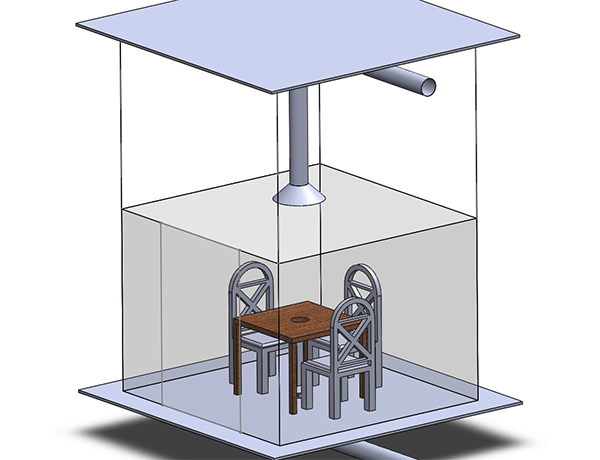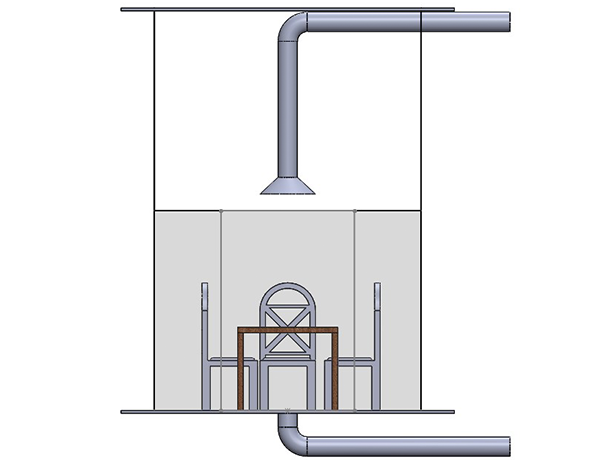
Five mechanical engineering seniors in the College of Engineering, Technology, and Architecture (CETA) designed an innovative ventilation system transforming how individuals experience indoor dining during COVID-19. This final project, initially for one of their courses, turned into a first-place winning idea during the Barney School of Business Pitch Competition on Nov. 17.
Jack Breton ’21, Jenny Parsons ’21, Drew Farkas ’21, Ian Walls ’21, and Dylan McAllister ’21 were students in this semester’s Thermal and Mechanical System Design course taught by Assistant Professor of Mechanical Engineering Kamau Wright. Over the past few months, Wright was inspired to incorporate design challenges related to his research interests in thermo-fluids analysis and engineering into his coursework. “I have emphasized using localized heating, cooling, and flow systems in common areas that people are interested in safely operating,” he says. “A tangible example is, going out to dinner with someone who is not in your household. Or inviting extended family over for dinner. Eating occurs without masks. How can we make these types of interactions safer?” The goal of the final project was for students to develop a novel design and solution with the goal of helping people to safely minimize social distance in various environments where SARS-CoV-2 is present and there is a risk of human-to-human transmission of COVID-19. The students worked together to use thermo-fluid analysis, supporting engineering concepts, research, and a spirit of innovation to bring their projects to life.
The students’ winning project is a ventilated table enclosure for restaurants that will isolate tables in an indoor dining environment. The goals of this project are to help control the spread of COVID-19 in indoor dining spaces by increasing airflow at each table and removing particles generated while talking or eating. The “dirty” air from each table is then filtered before being released outside the restaurant. As a business model, the students suggested how they could design, optimize, install, and lease out these systems to restaurants during the COVID-19 pandemic so restaurants could remain open and ensure they are continuing to make a profit while offering a safe dining experience.
It was Breton who discovered an Instagram post about the competition, which was open to all majors. He thought the team’s idea for the project was extremely relevant to the current times and was developed enough to be able to give a one-minute elevator pitch about it. “Aside from having an interest in technical engineering, I truly enjoy communicating ideas, public speaking, and developing my business skills, so I thought this would be the perfect opportunity to use those skills,” he says. “I am even more appreciative that the Barney School of Business allowed students from all majors to participate in the event because it shows just how exciting true collaboration can happen at UHart.”
Jack Breton ’21, mechanical engineering with acoustics concentrationI thought the competition was a great experience! As an engineering major with an interest in business, it’s rare that I get to use my ‘business side.’ In my design classes, we often focus so much on the engineering of a product that we do not stop and think about profitability. Having to brainstorm and develop ideas for how this system would be marketed was a very interesting and educational exercise. Having to present all aspects of our product and business idea within a minute was challenging and rewarding.

Part of CETA’s mission is ensuring students are given the proper tools to not only design problem-solving solutions, but also be able to talk about their ideas, research, and more. Therefore, there is a business-type component in much of the work CETA students do. The CETA Design Expo, for example, is a biannual event hosted at the end of each semester where students present their innovative projects. “This experience taught me how to prepare for project presentations, as well as strengthened my confidence and public speaking skills,” says Parsons. McAllister adds that CETA sets up students for success right after their first semester when they are placed into teams working towards a robotic design challenge. “CETA really gives students the tools to improve themselves year after year, as many participate in the expo up to three times during their time at UHart,” he says. Breton adds that CETA faculty especially understand the benefit of teaching students about business-oriented communication of ideas. “Classes like Engineering Practice with Dean Hisham Alnajjar really helped me understand the role that business plays in engineering,” he says. The students were in complete agreement that Wright is the type of faculty member who goes above and beyond to ensure students are successful in sharing their ideas.
Wright was consistently invested in his students’ ideas and made himself available to help and encourage the students throughout the entire design process. He took interest in this team’s project specifically because he had a similar idea of his own. “Dr. Wright was able to help us come up with improvements to implement on the design, but at the same time, he made sure to allow us to make a few mistakes and learn from them rather than just telling us exactly what to do,” Parsons says. “The most effective suggestion Dr. Wright made for us was to allow the top of the enclosure to remain open. He supported this idea by encouraging us to think about direction of flow and to tie that in with topics taught in class.” The hole in the middle of the table for helping to support the team’s ventilation strategies was another one of Wright’s key suggestions, directly toward the goal of helping to minimize social/physical distance by maximizing the local ventilation of the air between those sitting across from one another. Irina Naoumova, professor and chair of the Management, Marketing, and Entrepreneurship Department at UHart also recognized Wright, along with other CETA faculty, during an awards ceremony for the event. “I would like to thank Hisham Alnajjar, David Pines, and Kamau Wright, specifically, for preparing students for future success by focusing both on engineering aspects and applications to business,” she says.
As aspiring engineers, this added experience further helped the students understand the connection between business and engineering. Parsons mentioned even as someone pursuing mechanical engineering, she hopes to explore a role in management later in her career. “I believe it is very important to understand the role of business when pitching projects and ideas because you could have the best idea in the world, but if you do not know how to present it, no one will be interested,” she says. “It is also important to understand that as an engineer, sometimes you need to be able to present ideas in a way that a majority of people can understand. The technical aspect of a design is very important, but there must be proof that there is a market for the product and that the product will be affordable.” Breton has a long-term goal of owning his own company one day, “so learning as many business and communication skills as possible will surely help in the long run.” McAllister adds that in many companies, engineers end up working with other individuals who manage business and marketing aspects of the company. “This experience will give young engineers a competitive edge and even an easier acclimation process into major companies who have a large staff.”